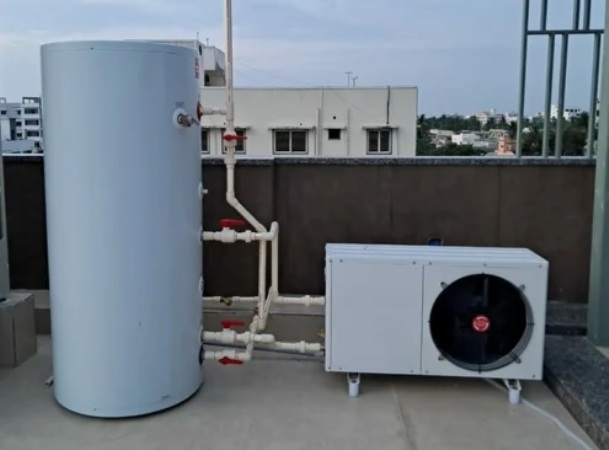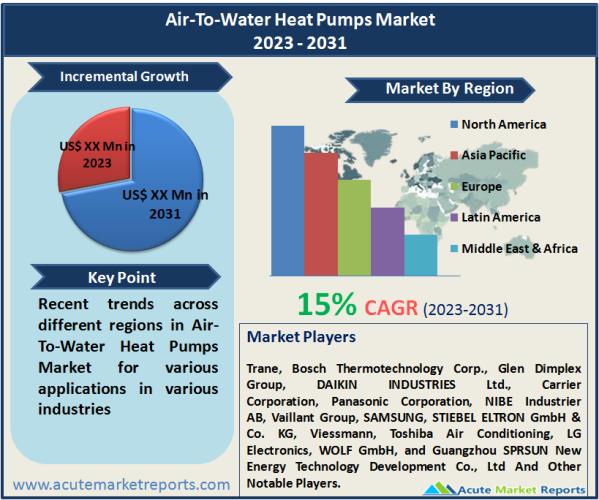
The market size for air-to-water heat pumps market is anticipated to expand at a CAGR of over 15% during the forecast period of 2025 to 2033. Notable public and private institutions have exerted considerable effort to improve the global operational performance of heat pump technologies. Using an example from April 2025, the IEA Heat Pumping Technologies Technical Collaboration Programme (IEA HPT TCP) published a study confirming that air-to-water (ATW) heat pump systems utilising propane (R290) significantly improve the energy efficiency of a building in comparison to other systems. Air-to-water (ATH) heat pump systems are also becoming increasingly popular in the residential markets of Europe and North America. In February 2025, for instance, new home construction projects in the United States increased by nearly 6.8%, representing an astounding 22% year-over-year increase.

Increasing Demand for Conventional Heating Systems
The increased availability of conventional heating and cooling systems that utilise renewable energy or fossil fuels may have a negative impact on the growth of the industry. On the other hand, the availability of functional advantages in terms of operational costs, incentives, and tax refunds may alleviate these constraints. To offset the cost barriers for customers, respective administrative authorities have also created advantageous programmes, such as power bill subsidies and tax incentives, to further encourage the implementation of these systems.
Increasing Urbanisation Will Fuel Demand for Residential Air to Water Heat Pumps
The residential applications segment of the air-to-water heat pump market is expected to experience significant growth due to rising population and urbanisation rates. Asia is home to nearly 54% of the global urban population. In fact, the region's urban population is projected to increase by fifty percent by 2050. This expanding population will result in an increase in the demand for hot water heating. The rising demand for space cooling and heating in residential buildings as a result of varying climatic conditions is also expected to contribute to the development of the regional economy. In addition, the introduction of favourable measures to meet rising consumer demand has resulted in the widespread adoption of advanced technologies, which has further boosted product adoption.
The growing demand for energy-efficient systems to reduce electricity bills and green building standards and codes will increase the market size of residential air-to-water heat pumps. According to the IEA, Europe made the largest investment in energy efficiency technologies in 2018, totalling 76 billion U.S. dollars. According to the U.S. Green Building Council, as of October 2019, the number of LEED (Leadership in Energy and Environmental Design) registrations in the United States had increased from 67,593 in 2018 to 69,066 in 2019. (USGBC).
Increasing Building and Housing Construction
During the forecast period, the demand for residential air-to-water heat pumps is anticipated to increase due to the expansion of the construction and housing industry for single-family and multifamily dwellings. According to Advanced Energy Economy, the building industry generated 298.48 billion U.S. dollars in advanced energy market revenue in 2018.
Increasing Urbanisation
Increasing urbanisation and industrialization, as well as rising discretionary income in emerging economies, will further enhance the industry landscape. According to the analysis conducted by the World Bank in 2019, 77.4% of Germany's population resided in urban areas and cities. In addition, 76.6% of the total population of Malaysia resided in urban areas and towns.According to the European Heat Pump Association, approximately 10% of the world's buildings are heated by heat pumps as of May 2019. This affords providers of residential air-to-water heat pumps a lucrative opportunity to tap into the untapped market, thereby boosting market growth over the forecast period.Individuals' growing adoption of innovative technologies, fuelled by their rising disposable income, will increase the product's market share. According to gov.uk, the real disposable income of actual households in the United Kingdom is projected to increase annually from 2017 to 2025, with the smallest annual increase rate being 0.4% between 2020 and 2021.
Reduction of Carbon Dioxide Emissions
Energy is essential to daily life as it is used to fuel businesses, hospitals, homes, and schools. However, energy production contributes to the emission of greenhouse gases. According to the EIA, the United States produced approximately 5.13 billion metric tonnes of CO2 emissions from energy consumption in 2019. In 2018, roughly 36.6 billion metric tonnes of carbon dioxide were released into the atmosphere.Carbon dioxide (CO2), one of the greenhouse gases, is produced in large quantities by the combustion of fossil fuels like coal, oil, and natural gas. Due to the increase in CO2 emissions, many nations aim to reduce their primary energy demand and implement policies to limit greenhouse gas emissions. The residential air-to-water heat pump provides an energy-efficient means of space heating, thereby driving market expansion.When air-to-water heat pump systems are utilised instead of fossil-fuelled methods, carbon emissions associated with energy consumption and generation can be reduced significantly. This is leading to an increase in the number of residential complexes equipped with energy-efficient heat pumps.
Market for Air to Water Heat Pumps, by Application
The market for air-to-water heat pumps in multifamily residential applications is expected to surpass USD 25 billion by 2033. Increasing private and government investments in the construction of multi-story residential structures have had a positive effect on multi-family structures. Increasing preference for energy-efficient, eco-friendly alternatives is one of the primary factors driving the rise in popularity of air-to-water heat pumps for residential use. Increasing government support in all regions will also play a significant role in reducing energy consumption.
Increasing Public Investments in North American Energy Efficiency Technologies
Due to the rising demand for space heating and cooling systems and the expansion of the real estate sector, the air-to-water heat pump market in North America is expected to grow at a rate of more than 15% through 2033. The regional government is engaged in a number of substantial initiatives for the adoption of dependable technologies to meet the rising demand for energy. In November 2025, for instance, the U.S. government announced funding of $9 billion to support the installation of energy-efficient systems, such as heat pumps, in residential applications. In addition, the presence of stringent regulatory measures to limit carbon emissions has accelerated the demand for these units, thereby creating a favourable business environment.
Expansion to Benefit Market Players in Enhancing Market Share
Trane, Bosch Thermotechnology Corp., Glen Dimplex Group, DAIKIN INDUSTRIES Ltd., Carrier Corporation, Panasonic Corporation, NIBE Industrier AB, Vaillant Group, SAMSUNG, STIEBEL ELTRON GmbH & Co. KG, Viessmann, Toshiba Air Conditioning, LG Electronics, WOLF GmbH, and Guangzhou SPRSUN New Energy Technology Development Co., Ltd. are the leading companies in the air-to- These well-known manufacturers and suppliers are reorganising their research and development expenditures to expand their product lines and meet the rising demand for efficient and dependable space heating technologies.
In October 2025, for instance, Daikin announced the expansion of its heat pump manufacturing facility in Güglingen, Germany. The company acquired a 22,000-square-meter plot of land in Güglingen, where its office and production facilities are located. By 2025, Daikin will be able to produce over three times its current volume as a result of the integration and refurbishment of facilities at its existing manufacturing site.
Historical & Forecast Period
This study report represents analysis of each segment from 2023 to 2033 considering 2024 as the base year. Compounded Annual Growth Rate (CAGR) for each of the respective segments estimated for the forecast period of 2025 to 2033.
The current report comprises of quantitative market estimations for each micro market for every geographical region and qualitative market analysis such as micro and macro environment analysis, market trends, competitive intelligence, segment analysis, porters five force model, top winning strategies, top investment markets, emerging trends and technological analysis, case studies, strategic conclusions and recommendations and other key market insights.
Research Methodology
The complete research study was conducted in three phases, namely: secondary research, primary research, and expert panel review. key data point that enables the estimation of Air-To-Water Heat Pumps market are as follows:
Market forecast was performed through proprietary software that analyzes various qualitative and quantitative factors. Growth rate and CAGR were estimated through intensive secondary and primary research. Data triangulation across various data points provides accuracy across various analyzed market segments in the report. Application of both top down and bottom-up approach for validation of market estimation assures logical, methodical and mathematical consistency of the quantitative data.
| ATTRIBUTE | DETAILS |
|---|---|
| Research Period | 2023-2033 |
| Base Year | 2024 |
| Forecast Period | 2025-2033 |
| Historical Year | 2023 |
| Unit | USD Million |
| Segmentation | |
Application
| |
Product
| |
Commercial
| |
|
Region Segment (2023-2033; US$ Million)
|
Key questions answered in this report